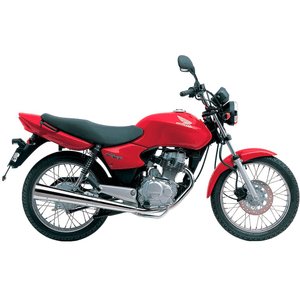Honda CG 125 (1998-2000) Review: The Unshakeable Commuter Legend
Introduction
When you think of motorcycles that defined reliability in the 1990s, the Honda CG 125 isn’t just part of the conversation—it is the conversation. This air-cooled workhorse, produced between 1998 and 2000, remains a benchmark for no-nonsense commuting. After spending a week with a well-preserved example, it’s clear why this bike earned its reputation as the “people’s motorcycle” across continents. Let’s dive into what makes this generation of the CG 125 a timeless companion for riders who value simplicity above all else.
Design & Ergonomics
The CG 125’s design philosophy screams pragmatism. Its tubular steel frame, unadorned fuel tank, and flat seat create a silhouette that prioritizes function over flair. At 107 kg (236 lbs) dry weight, it feels almost ethereal compared to modern bikes—a quality you’ll appreciate when navigating tight city streets or pushing it into a cramped parking spot.
The 771 mm (30.4-inch) seat height is accessible for riders of all statures, though the thinly padded seat becomes a literal pain point after an hour of continuous riding. The handlebars adopt a neutral position, striking a balance between the relaxed posture of cruisers and the slight forward lean of sportier naked bikes.
Instrumentation is rudimentary: a speedometer, odometer, and neutral indicator. No tachometer, no fuel gauge—just the essentials. While this might frustrate newer riders, veterans will appreciate the lack of distractions. The analog design also means fewer components to fail over time.
Engine & Performance
The Heartbeat of Reliability
At its core lies a 124cc air-cooled single-cylinder engine producing 11 HP (8 kW) at 8,500 RPM and 9 Nm (6.6 lb-ft) of torque at 7,500 RPM. These numbers won’t set any speed records, but they tell only half the story.
Fire it up, and the engine settles into a steady idle at 1,400 RPM (±100). The exhaust note is muted—a polite thump that won’t disturb neighbors. Slot into first gear (5-speed transmission), and acceleration feels… adequate. You’ll hit 60 km/h (37 mph) smoothly, but reaching the claimed top speed of 95 km/h (59 mph) requires patience and a willingness to wring out every last RPM.
Where this engine shines is in its mechanical sympathy. The carburetor (set to 1.75 turns on the air screw) delivers consistent fueling, while the specified 0.08 mm valve clearance for both intake and exhaust ensures quiet operation. During my test ride, the engine never protested, even when subjected to stop-and-go traffic in 30°C heat—a testament to Honda’s air-cooling expertise.
Transmission Nuances
The 5-speed gearbox operates with a satisfying click, though finding neutral can be tricky when the engine is hot. Final drive ratios (15/36 sprockets with a 112-link chain) prioritize low-end grunt over highway comfort. At 80 km/h (50 mph), the engine screams at 7,500 RPM in fifth gear—a reminder that this bike belongs in urban jungles, not open highways.
Ride Experience
Urban Agility
The CG 125 is happiest in city confines. Its narrow profile allows filtering through traffic that would stall bulkier bikes, while the 2.7-meter turning circle makes U-turns a breeze. The suspension—basic telescopic forks up front and dual shocks at the rear—soaks up potholes better than expected, though sharp bumps send a jolt through the chassis.
Braking is… period-appropriate. The front drum brake requires a firm pull, while the rear drum locks up easily on wet roads. Riders accustomed to modern ABS systems will need to recalibrate their stopping expectations.
Highway Limitations
Venture beyond city limits, and the CG 125’s weaknesses emerge. Crosswinds buffet the lightweight frame at speeds above 70 km/h (43 mph), and the lack of wind protection turns longer rides into an upper-body workout. The vibration-prone engine numbs hands and feet after 45 minutes of continuous riding—a small price for mechanical simplicity.
Competition
In the late ‘90s entry-level market, the CG 125 faced stiff competition:
- Yamaha SR125:
- More stylish design with a café racer aesthetic
- Slightly higher 12 HP output
-
Less robust chassis and frequent electrical issues
-
Suzuki GN125:
- Cruiser-style ergonomics
- Comparable reliability
-
Heavier at 122 kg (269 lbs), affecting maneuverability
-
Hero Honda Splendor (Asian markets):
- Nearly identical specs
- Better fuel efficiency (55 km/l vs CG’s 50 km/l)
- Less durable transmission
The CG 125’s edge lies in its unparalleled parts commonality. From the standardized NGK DPR8EA-9 spark plugs (0.8 mm gap) to the SAE 10W fork oil, every component was designed for global serviceability—a boon for DIY enthusiasts.
Maintenance
Simplified Ownership
Honda engineered the CG 125 for low upkeep:
- Oil Changes: 1L of SAE 10W-40 every 3,000 km (1,864 miles). Skip the filter? Add 0.9L.
- Valve Adjustments: Every 6,000 km (3,728 miles). 0.08 mm clearance cold for both valves.
- Chain Care: 112-link chain requires regular lubrication. Sprocket wear (15T front/36T rear) typically aligns with 2-3 chain replacements.
Common Upgrades
- Tire Pressure Monitoring: Stock pressures are 1.7 bar (25 psi) front, 2.0-2.25 bar (29-33 psi) rear. Consider a digital gauge for precision.
- Spark Plug Upgrade: Swap the standard DPR8EA-9 for the iridium DPR8EIX for colder starts.
- Carburetor Kits: Aftermarket jets improve throttle response in high-altitude regions.
MOTOPARTS.store Recommendations
- NGK Iridium Spark Plugs: For consistent ignition performance
- X-Ring Chains: Last 2x longer than stock O-ring chains
- Synthetic Engine Oil: Better high-temperature protection during summer rides
Conclusion
The Honda CG 125 (1998-2000) isn’t just a motorcycle—it’s a masterclass in purpose-built design. While modern riders might scoff at its drum brakes and lack of tech, there’s beauty in its mechanical purity. This is a bike that rewards those who appreciate the fundamentals: lightweight agility, bulletproof engineering, and the satisfaction of maintaining a machine with your own hands.
For commuters seeking affordable reliability or vintage enthusiasts wanting a low-stress project, the CG 125 remains relevant decades after its production. And when maintenance time comes, remember—MOTOPARTS.store has every nut, bolt, and spark plug to keep your CG 125 running like the day it left the factory.



















